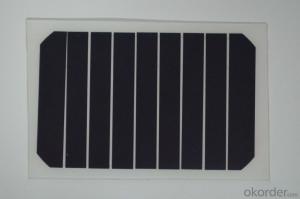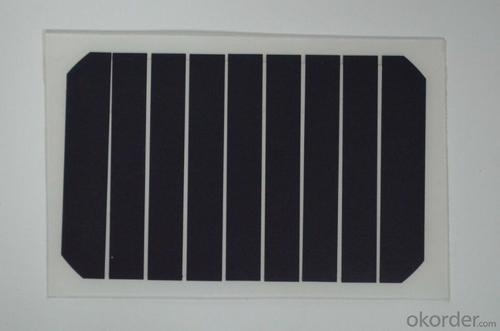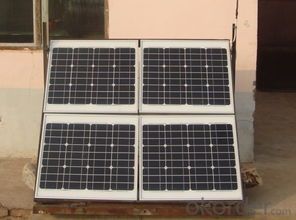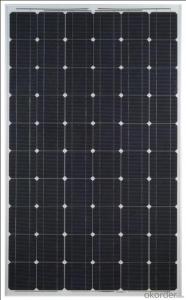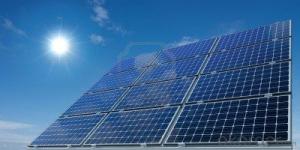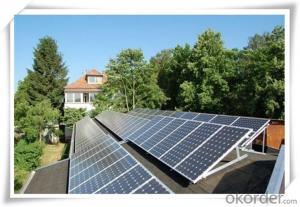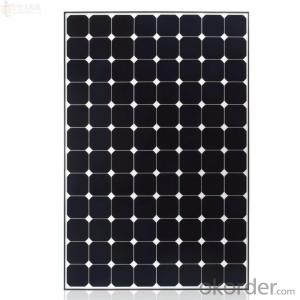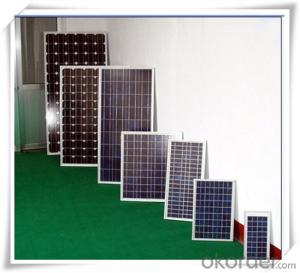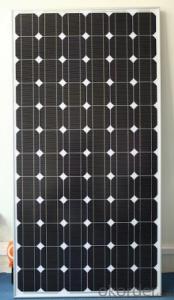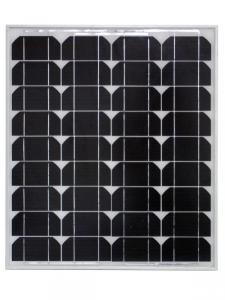300 Watt High Quality 3W to 5W Monocrystalline Solar Panel CNBM
- Loading Port:
- Qingdao
- Payment Terms:
- TT OR LC
- Min Order Qty:
- 10 set
- Supply Capability:
- 300000 set/month
OKorder Service Pledge
OKorder Financial Service
You Might Also Like
3W to 185W Monocrystalline Solar Panel
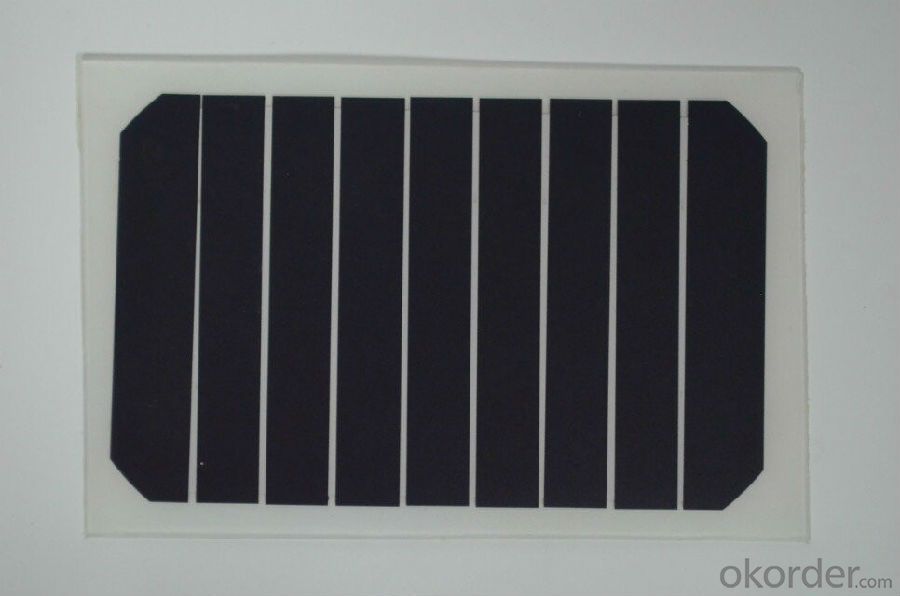
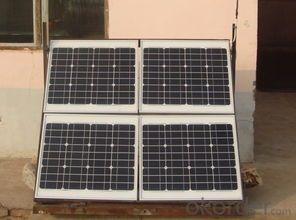
Monocrystalline Solar Modules
We offers a range of small, medium and large monocrystalline solar modules, designed for a range of requirements.
Specifications:
Tolerance | +/- 3% |
Cell | Monocrystalline silicon solar cells |
N0. of Cells | 72 (12 x 6) |
Dimension of Modules (mm) | 1581 x 809 x 40 |
Weight (kg) | 15.5 |
Limits:
Operating Temperature | -40~+85? |
Storage Temperature | -40~+85? |
Maximum System Voltage | 1000 VDC max. |
Hail Impact | Diameter of 28mm with impact speed of 86km/h |
Temperature and Coefficients:
NOCT | 48C+/-2? |
Voltage temperature coefficient (%/K) | -0.34 |
Current temperature coefficient (%/K) | 0.09 |
Power temperature coefficient (%/K) | -0.37 |
Characteristics:
Model: | SGM-160D | SGM-165D | SGM-170D |
Max-power voltage Vmp (V) | 34.5 | 35.4 | 35.8 |
Max-power current Imp (A) | 4.64 | 4.66 | 4.75 |
Open-circuit voltage Voc (V) | 41.75 | 43.6 | 43.32 |
Short-Circuit Current Isc (A) | 5.32 | 5.08 | 5.38 |
Max-power Pm(W) | 160 | 165 | 170 |
Model: | SGM-175D | SGM-180D | SGM-185D |
Max-power voltage Vmp (V) | 36.1 | 36.2 | 36.2 |
Max-power current Imp (A) | 4.85 | 4.97 | 5.11 |
Open-circuit voltage Voc (V) | 43.68 | 43.8 | 44.8 |
Short-Circuit Current Isc (A) | 5.49 | 5.48 | 5.51 |
Max-power Pm(W) | 175 | 180 | 185 |
STC: Irradiance 1000W/m2, Module temperature 25?, AM=1.5
Monocrystalline Solar Panels Specifications Range
Maximum Power (Pm) | Dimension | Weight | Operating Voltage (Vmp) | Operating Current (Imp) | Open Circuit Voltage (Voc) | Short Circuit Current (Isc) |
3W | 158x241x25mm | 0.5kg | 8.5V | 0.36A | 10.5V | 0.4A |
4W | 308x166x25mm | 0.77kg | 8.5V | 0.47A | 10.5V | 0.54A |
4W | 308.x166x25mm | 0.77kg | 16.8V | 0.24A | 21V | 0.27A |
5W | 296x215x25mm | 0.3kg | 16.8V | 0.48a | 21V | 0.54A |
10W | 286x406x25mm | 1.5kg | 16.8V | 0.59A | 21V | 0.66A |
12W | 286x406x25mm | 1.5kg | 16.8V | 0.71A | 21V | 0.8A |
14W | 286x541x25mm | 2kg | 16.8V | 0.83A | 21V | 0.96A |
16W | 286x541x25mm | 2kg | 17.2V | 0.93A | 21.5V | 0.99A |
18W | 296x541x25mm | 2.4kg | 18.8V | 1.07A | 21V | 1.2A |
20W | 296x641x25mm | 2.4kg | 17.2V | 1.15A | 21.5V | 1.24A |
24W | 541x451x25mm | 3.15kg | 16.8V | 1.14A | 21V | 1.56A |
26W | 541x451x25mm | 3.15kg | 17.2V | 1.51A | 21.5V | 1.63A |
30W | 296x966x25mm | 3.85kg | 16.8V | 1.78A | 21V | 2.03A |
36W | 541x641x35mm | 4.7kg | 16.8V | 2.14a | 21V | 2.4A |
40W | 541x641x35mm | 4.7kg | 17.2V | 2.33A | 21.5V | 2.5A |
55W | 1057x457x35mm | 6.6kg | 17.6V | 3.12A | 21.6V | 3.3A |
70W | 546x1196x35mm | 8.5kg | 16.8V | 4.15A | 21V | 4.7A |
75W | 546x1196x35mm | 8.5kg | 17.2V | 4.36A | 21.5V | 4.8A |
80W | 546x1196x35mm | 8.5kg | 17.6V | 4.55A | 21.6V | 4.9A |
110W | 1066x811x40mm | 11.8kg | 17.6V | 6.25A | 21.6V | 6.6A |
150W | 1066x811x40mm | 14kg | 34.4V | 4.36A | 43.2V | 4.7A |
- Q: I'm looking for a solar panel that has something you can plug thigs into, I don't know let's say grow lights. I want something that these lights can plug directly into and I can't find any online. If there is any I would like to know of the cheapest and best quality, I know that's an oxymoron but still. The lights are 600 watts so I need something somewhat strong. Thanks
- Are you looking for the best and Affordable Solar Panels? Find and compare brands of Solar Panels for home power systems. Contact us today for more details.
- Q: I think that solar panels are the future and i think that the conventional way of generating electricity is going to be replaced by solar panels. I would like to be part of this industry as an entrepreneur but i do not know how to since i do not have a technical background. I would like to sell solar panels to consumers and to business. Should I start a manufacturing company that manufactures solar panels? Should I buy solar panels from manufactures and sell them to consumers? What should I do?
- Manufacturing your own electrical solar panels is out of the question. They are built much like computer chips and setting up a plant to do this would cost millions of dollars. You could become a solar system installer. These businesses install solar systems on homes and are paid for this service. You will need a significant amount of technical training to do this though, I would guess at least two years (the last thing you would want to do is damage someones home or design a system that is dangerous). I would suggest that you go into business making energy improvements to homes that do not involve solar energy. Most people can get the best value for their money by improving the air tightness of their homes (several tubes of well placed caulk). Other things you could offer would be the upgrading of door, Windows and electrical box seals. Insulation jackets around hot water heaters is also something a small firm could offer home owners. Other energy improvement are also possible and you could offer a whole shopping list of improvements to a customer. Good luck
- Q: Can solar panels be used for powering Wi-Fi networks?
- Yes, solar panels can be used to power Wi-Fi networks. Solar panels generate electricity from sunlight, which can be stored in batteries or directly used to power Wi-Fi routers and other network equipment. This allows for the creation of off-grid Wi-Fi networks in remote areas or during power outages, providing reliable and sustainable connectivity.
- Q: how efficient are flexible solar panels?
- I don't have a number, but in general, no one uses a flexible panel unless they are compelled to. The efficiency is lower, and my experience is that they don't last. I had one a few years ago, and it lasted less than 2 years. My rigid panels came with a 25-year performance warranty, and are still working great after 7 years.
- Q: Can solar panels be installed on a government building?
- Yes, solar panels can be installed on a government building. In fact, many government buildings have already implemented solar energy systems to reduce their carbon footprint and lower energy costs.
- Q: Can solar panels be used in areas with high levels of dust or dirt?
- Yes, solar panels can be used in areas with high levels of dust or dirt. However, regular cleaning and maintenance of the panels may be required to ensure optimal performance. Dust or dirt accumulation on the panels can reduce their efficiency and affect the amount of sunlight they can convert into electricity.
- Q: What is the impact of roof age on solar panels' efficiency?
- The impact of roof age on solar panels' efficiency can vary depending on the specific condition of the roof. In general, an older roof may need repairs or replacement before installing solar panels to ensure proper installation and optimal performance. Additionally, an aged roof may have structural issues or shading problems that can affect the efficiency of solar panels. Therefore, it is important to assess and address any roof concerns before installing solar panels to maximize their efficiency and longevity.
- Q: Can solar panels be used in areas with high levels of vandalism?
- Solar panels can be used in areas with high levels of vandalism, but additional precautions may need to be taken to protect them from potential damage.
- Q: How efficient are the solar panels....?
- Commercial monocrystalline panels are typically 8% efficient but inverters can be 65% to 90% efficient and lead acid batteries are 50% efficient at charging and 92% efficient at discharging plus they self-discharge at 3% to 20% per month.
Send your message to us
300 Watt High Quality 3W to 5W Monocrystalline Solar Panel CNBM
- Loading Port:
- Qingdao
- Payment Terms:
- TT OR LC
- Min Order Qty:
- 10 set
- Supply Capability:
- 300000 set/month
OKorder Service Pledge
OKorder Financial Service
Similar products
Hot products
Hot Searches
Related keywords
